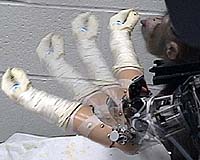 |
Stockholm, Sweden (UPI) Dec 22, 2010 Swedish scientists say they've discovered a molecule that could lead to new rocket fuels that are 20 percent to 30 percent more efficient than now. Researchers at the Royal Institute of Technology (KTH) discovered the new molecule in the nitrogen oxide group and dubbed it trinitramid, a release from the Swedish Research Council reported Wednesday. More efficient fuels translate into bigger rocket payloads, the researchers said. "A rule of thumb is that for every 10 percent increase in efficiency for rocket fuel, the payload of the rocket can double," Tore Brinck, professor of physical chemistry at KTH, said. "What's more, the molecule consists only of nitrogen and oxygen, which would make the rocket fuel environmentally friendly. "This is more than can be said of today's solid rocket fuels, which entail the emission of the equivalent of 550 tons of concentrated hydrochloric acid for each launch of the space shuttle." "As mentioned, what is specific to this molecule is that it contains only nitrogen and oxygen. Only eight such compounds were previously known, and most of them were discovered back in the 18th century," he said. The scientists have managed to produce enough of the compound in a test tube for it to be detectable and subject to analysis. "It remains to be seen how stable the molecule is in a solid form," Brinck said.
Share This Article With Planet Earth
Related Links Rocket Science News at Space-Travel.Com
 Robot Arm Improves Performance Of Brain-Controlled Device
Robot Arm Improves Performance Of Brain-Controlled DeviceChicago IL (SPX) Dec 20, 2010 The performance of a brain-machine interface designed to help paralyzed subjects move objects with their thoughts is improved with the addition of a robotic arm providing sensory feedback, a new study from the University of Chicago finds. Devices that translate brain activity into the movement of a computer cursor or an external robotic arm have already proven successful in humans. But in ... read more |
|
| The content herein, unless otherwise known to be public domain, are Copyright 1995-2010 - SpaceDaily. AFP and UPI Wire Stories are copyright Agence France-Presse and United Press International. ESA Portal Reports are copyright European Space Agency. All NASA sourced material is public domain. Additional copyrights may apply in whole or part to other bona fide parties. Advertising does not imply endorsement,agreement or approval of any opinions, statements or information provided by SpaceDaily on any Web page published or hosted by SpaceDaily. Privacy Statement |